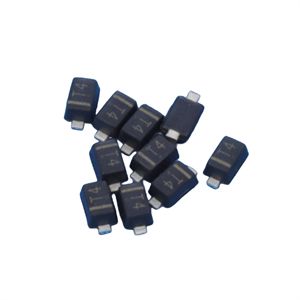Date:2024-10-16 Categories:Product knowledge Hits:322 From:Guangdong Youfeng Microelectronics Co., Ltd
What is Schottky diode?
Schottky diode is a special type of diode mainly composed of metal and semiconductor materials, utilizing the Schottky barrier between the metal and semiconductor for rectification.
Characteristics of Schottky diodes:
Low forward voltage drop: usually between 0.2 and 0.3 volts, significantly lower than ordinary PN junction diodes.
Fast switching speed: Due to the small minority carrier storage effect, its switching speed is fast.
Higher leakage current: At high temperatures, the leakage current is greater than that of traditional silicon diodes.
Application areas:
Schottky diodes are widely used in fields such as switching power supplies, frequency conversion, and power management.
What is an electrostatic diode?
Electrostatic diode is a semiconductor device used to protect circuits from the effects of electrostatic discharge (ESD). It can quickly respond and conduct high voltage, thereby protecting sensitive components from damage.
Characteristics of electrostatic diodes:
High transient voltage protection: capable of withstanding transient voltages up to several thousand volts.
Fast response time: able to quickly respond and conduct at the nanosecond level.
Low capacitance: will not have a significant impact on high-speed signals.
Application areas:
Electrostatic diodes are mainly used to protect sensitive electronic devices such as communication ports, data lines, and microprocessors from electrostatic discharge damage.
The difference between Schottky diodes and electrostatic diodes
Working principle difference: Schottky diodes achieve rectification based on the potential barrier generated by metal semiconductor contacts, while electrostatic diodes use PN junctions or multi-layer structures to quickly conduct at high voltages to protect the circuit.
Main functional differences: Schottky diodes are mainly used for rectification and high-efficiency power conversion, while electrostatic diodes are used to protect circuits from electrostatic damage.
Different voltage characteristics: Schottky diodes have low forward voltage drop and high reverse leakage current, while electrostatic diodes are almost non-conductive under normal operating conditions and only rapidly conduct at high voltages.
Application scenario differences: Schottky diodes are commonly used for power management and high-frequency circuits, while electrostatic diodes are widely used for ESD protection of various electronic devices.
Although Schottky diodes and electrostatic diodes belong to the diode family, they have significant differences in their working principles, functions, voltage characteristics, and application scenarios. Understanding these differences is crucial for electronic engineers to design safe and efficient electronic circuits.

Previous: Classification, Structure, and Principle of MOSFET
Next: Using voltage inspection method to quickly locate fault points in integrated circuits